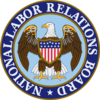Pre-Wagner Act labor relations
The struggle of workers in 18th and 19th Century America to improve their working conditions led to the beginnings of a national labor policy. When the United States entered World War I in 1917, the labor movement had grown to 3 million members. President Woodrow Wilson took steps to promote labor peace by creating a tri-partite War Labor Board in 1918. Although the War Labor Board did not have enforcement powers, labor and management agreed to refrain from strikes or lockouts as a result of its mediating efforts. The War Labor Board recognized the "right to organize in trade unions and to bargain collectively through chosen representatives."
The Labor-Management truce during World War I evaporated after the armistice in 1918. The following year, unions lost major strikes in the steel, coal, and rail industries. Union membership dropped from more than five million members in 1920 to three million members in 1933—just 300,000 more than in 1914. Hostility between labor and management ran high in the 1920s. It was during this
period that the use of the labor injunction to stop strikes reached its peak. Passage of the Railway Labor Act in 1926, stressing the importance of collective bargaining to minimize strikes and lockouts on railways, was a breakthrough in paving the way for a national labor policy.
In the depths of the Great Depression, during the last year of the Hoover Administration in 1932, Congress passed the Norris-LaGuardia Act, which curbed the power of the courts to issue injunctions or restraining orders against strikes, absent violence or fraud. Congress declared the policy of the United States to be that workers were free to join unions and bargain collectively.
Photos (top to bottom): Drilling Department, National Cash Register Company, Dayton, Ohio, 1902; City Mission, Dubuque, Iowa, April, 1930; Police attacking striking textile workers, Passaic, N.J., 1926.


